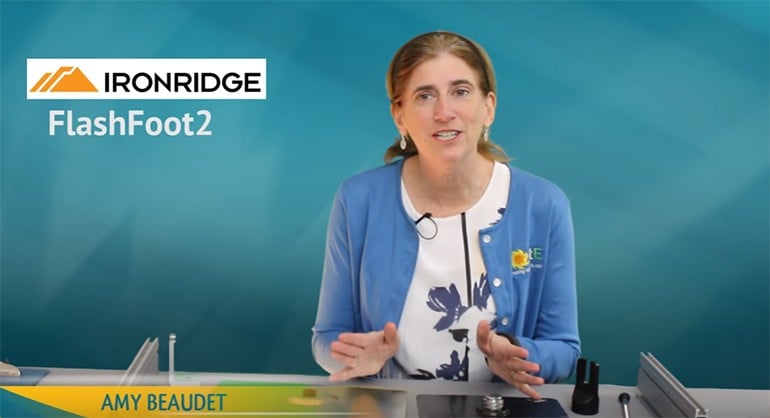
Introducing the IronRidge FlashFoot2
We are here today to introduce the new IronRidge FlashFoot2 flashing system for mounting your solar power system on a shingled roof. We demonstrate how the FlashFoot2 works and how it compares with the original FlashFoot, or FlashFoot1.
Full Transcript
With the original FlashFoot1, you can see that it actually has a little metal disk on the back, and it has an EPDM ring. And then you would get the L-foot that has a little bit of a cone inside there, and would fit right down on there, and make a nice seal. And then you would simply bolt your rail right to there.
What IronRidge has done with the FlashFoot2 is several different things to improve on this design.
- They’ve made it actually a little bit smaller. You can see the length is the same, but the width is considerably smaller. It will still give you the same protection, just takes up a little bit less space.
- The edges are nice and curved, so that makes it a lot easier when you are going up under the shingle, you’re not going to be catching on it and you”re not going to be cutting yourself on it.
- The FlashFoot2 has a 3 part tiered stacked system to help keep the rain out from your roof penetrations.
- It’s got a disk on the back, and it’s nice because it’s a little bit wider than where your hole would be. So say you are looking for the rafter, and you drill through, and you don’t quite catch it so you’ve got to seal that and then move over a little bit. This will cover any “oopsies,” and will give you a nice water tight protection over that.
- Reinforcement ribs. You can see it’s ridged, so it’s got the extra strength with the ridges. And it’s a nice guide, again, say this is my shingle, you can really use that as a guide to make sure you are getting things centered to where you are going. It also has got these little side indicators too, so that you can be sure to get it nice and straight.
- A really cool thing about the FlashFoot2 is it’s got this threaded standoff. What it does is, because you’ve got your little bit of a lip, and then you’ve got this raised, you’ve got about an inch between where any water potential could be and the bottom. So you’ve got an inch of raised surface to keep that rain from coming out of it. But, you’re still not going to get any rain in there, because it comes with a lag bolt that has a nice sealing washer on it. So, you are going to just drive that down with a 7/16″ ratchet.
- Twist-on Cap. And then it’s got this cap! This cap just screws right on it and completely encapsulates it. It protects it from all water. Instead of a separate L-foot that’s going to be offset like this, you’ve got your L-foot right on there. You can see the old way had a little bit of an offset, so any upload or down force, it was offset a little bit. With the new FlashFoot2, you’ve got the weight directly over it – you don’t have any offset. You’ve got a higher upload wind force for this.This is going to be able to withstand higher wind and higher snow load. Very important on a roof.
What if you are not doing your rails going across the roof? What if you are going up? Well, simple as can be. You just rotate the cap 90 degrees, and it will give you the ability to go up the roof. Really, really cool.
Bolt Not Included
One very important thing to note. The FlashFoot2 does not come with the bolt to connect the rail to the foot and there’s a good reason for that. It’s available in two different models. So you’ve got a square bolt, and you’ve got a T-bolt.
With the square bolt, you just slide it up to where it needs to go and then you just drop it, right down onto the foot.
With the T-bolt, you can just start at any location, and when you drop it in here, and tighten it up, it’s just going to stay right there. So if you’ve got a 17′ rail, you don’t have to drag it all the way down into it.
The FlashFoot2 does not come with these bolts because some people prefer the square, some people prefer the T-bolt. So to give you your choice, you’ve got to make sure you order them. They are an add-on to the FlashFoot2 – just make sure you select the same number of bolts as you select for the FlashFoot2.
Structural Certification
Now this has got all kinds of code compliances, so really is going to make your building inspector happy, going to be completely rain resistant. It is actually the only solution that has passed the wind driven rain test, so this is going to give you the utmost protection for your roof.
Additional Note
One thing to note, if you are transitioning from the old FlashFoot, the FlashFoot1, to the FlashFoot2, do note that because of that offset, you’re not going to want to put these both in the same row. If you’ve got a rail that you are trying to install, these will be offset from each other. So if you do have a mixture of some of the old and some of the new, make sure you keep all of the new on one rail, and all of the old on another rail – that will give you the ability to make sure everything lines up nicely.
